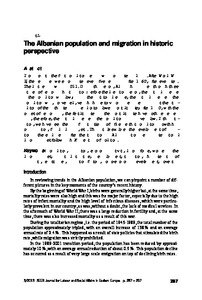The Albanian population and migration in historic perspective

SEER. Journal for Labour and Social Affairs in Eastern Europe
2013
16
3
287-297
census ; demography ; migration ; unemployment
Migration
http://www.nomos-zeitschriften.de/
English
Bibliogr.
"In our country the first population census was conducted in 1923. After World War II, the censuses were conducted every five years and after 1960, after every ten. The last census was in 2011. During this period, Albania has passed through three stages of demographic transition: before the liberation period, the natural increase in the population was low; during the dictatorial regime, the natural increase in the population was, conversely, very high due to various measures aiming at the stimulation of the birth rate and due also to a lower mortality rate; after 1990, with the onset of democracy, the fertility rate and the mortality rate have both decreased and, therefore, the natural increase in the population is again very low. In this situation, we have seen the significant patterns of influence that population growth has on migration, family planning, etc. This article explores the development of migration in the early years after the transition as Albania introduced an international labour market following half a century of isolation. "
Digital;Paper
The ETUI is co-funded by the European Union. Views and opinions expressed are however those of the author(s) only and do not necessarily reflect those of the European Union or the ETUI.